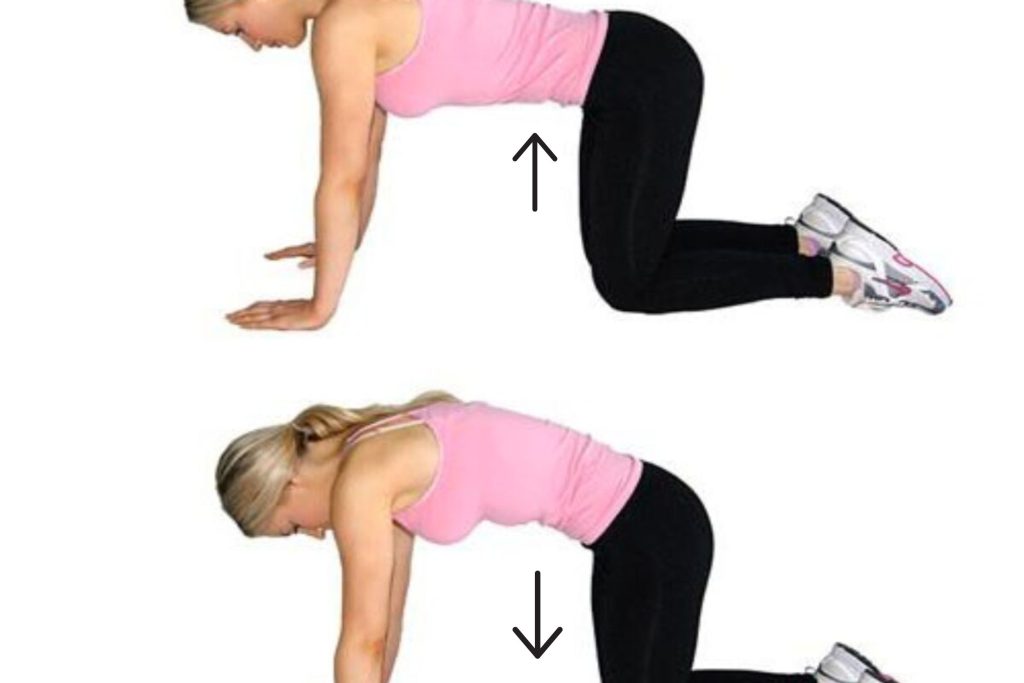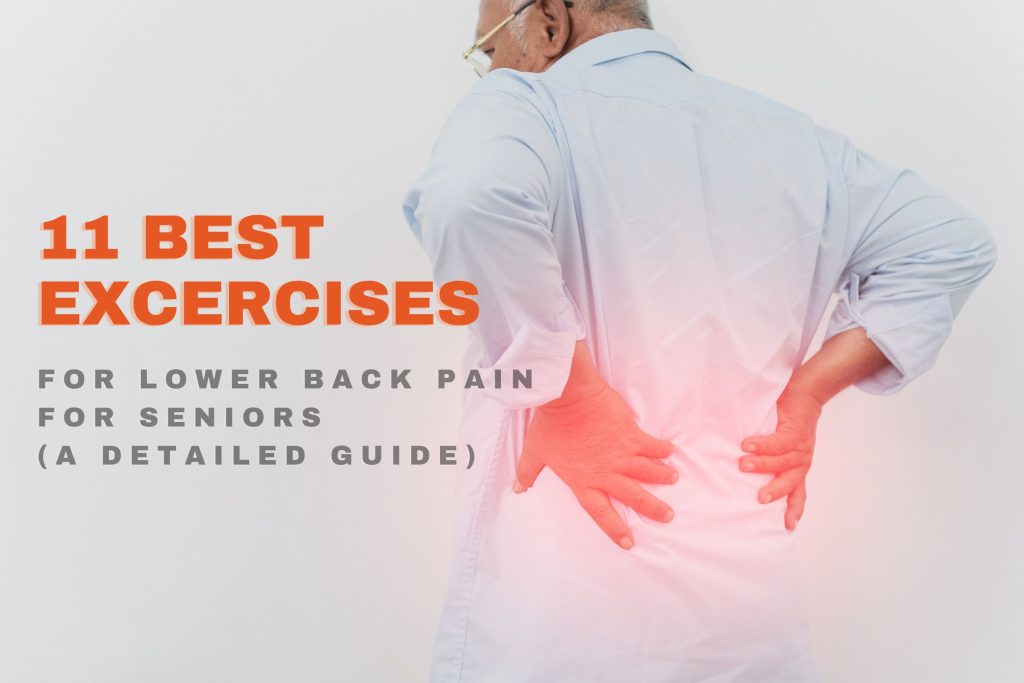Recently updated on May 30th, 2024 at 11:38 am
If you’re someone who suffers from lower back pain, you’re not alone. According to the National Institutes of Health, back pain, ranging from dull and constant aches to stabs of sharp pain, is a widespread health problem that affects eight out of 10 people during their lifetime.
Lower back stretches will help seniors ease joint and muscle stiffness, increase flexibility, heal from muscle and ligament injuries, and enjoy better health as they age. Stretching at least several times a week can help prevent injuries caused by exercise or exertion on weak or tight muscles that struggle to extend the way they need to.
Regular stretching will decrease seniors’ risk for muscle damage, back strains, and joint pain, so join us as we dive into these exercises and empower you to take charge of your personal care for a pain-free back and enhanced quality of life.
1. Reverse Straight Leg Raise
 Low back pain exercises for seniors and the elderly, such as eccentric straight leg raises, are known to stabilize and strengthen your lower back while reducing the pain associated with lumbar instability.
Low back pain exercises for seniors and the elderly, such as eccentric straight leg raises, are known to stabilize and strengthen your lower back while reducing the pain associated with lumbar instability.
This exercise works your hip and abdominal flexor muscles, which will improve your ability to get out of a chair, get out of a bed, and maintain your posture.
Start by lying on your back and tightening up your abdominal muscles. Then bring your right knee toward your chest while straightening your right leg. Then slowly lower your leg to the floor and repeat this exercise ten times with both legs.
For the breathing part during this exercise, inhale during the upward movement phase and exhale during the downward movement phase.
When you can do ten effortlessly, you can increase up to 20 times on each leg. Try alternating ten on each side and repeat for another ten if you can not perform 20 in a row.
It’s crucial to remember that when performing leg exercises lying down, make sure to press your back into the ground while holding your pelvis as still as possible throughout the movement.
2. Curl-ups

Start by laying on your back with your knees bent and your arms on your chest. Tighten your abdominal muscles before you breathe in. Exhale as you lift your shoulders off the ground. Pause in between to keep stomach muscles tight. Start from the beginning and repeat ten times.
Just like in the reverse straight leg raise, inhale during the upward movement phase and exhale during the downward movement phase.
Remember to constantly breathe in through your nose and out through your mouth. Keep your back protected by pressing it to the floor, and give your neck extra support to avoid pain by placing your hands behind your head.
3. Cat and Camel

The purpose of the cat and camel exercises for lower back pain for seniors is to stretch and extend those and mid back muscles. It is also an excellent exercise to loosen up the pelvic area and to learn the pelvic tilt.
Start by getting on your hands and knees on the bed or the floor only if you have the means to get back up safely. Keep your back in a neutral position. Then round your back up and let your head down to imitate a cat arching his back. The next step is to reverse by relaxing your back, forming the valley between the camel’s two humps. Start all over again and repeat ten times.
4. Back Extension

The more we age, our spine and head begin to curve forward with the effect of gravity and poor posture. This will create mechanical problems like mid-back or thoracic spine pain.
To reduce the risk of the problems associated with poor posture occurring, we must perform a movement in the opposite direction as your curvature. This is called spinal extension. Start by lying face down on your bed or the floor with your palms facing down next to your face. Slowly bring your head back up while arching your back. Start from the beginning and repeat the exercise ten times.
Make sure to continue breathing in through your nose and out through your mouth while your hips are maintained on the floor.
5. Bridging

During this exercise, when you raise your bottom off the ground, you simultaneously strengthen your buttock muscles and increase the range of motion in the hip flexors.
This essential exercise is critical to learn, especially if you spend most of your time in bed. It will help you prevent bed sores and strengthen your ability to reposition your body when you lift your bottom off the bed. Simply put, bridging will help support the buttock muscles, hip extensors, and hamstrings. It will also help strengthen the low back and sacroiliac, which can improve your ability to stand and maintain your balance.
Start by lying on the floor with your knees bent and your hips in a neutral position. Lift up your bottom high enough that you’re comfortable off the floor. Pause for a moment before you start the exercise from the beginning. Repeat it ten times.
6. Pelvic Tilt

This fundamental movement increases the range of motion and flexibility of the pelvic region. You can perform this exercise either sitting or standing. However, lying down enables your entire body to relax and your hips to feel the ground for better execution of the movement.
The purpose of the pelvic tilt is to stretch the lower back and hip muscles, making it an ideal exercise for sore backs after a long day of walking.
Start by lying down on the bed or floor with your knees bent. Then tighten your abdominal muscles and press your back into your bed or the floor. Relax all your muscles after a pause before you start again. Repeat the exercise ten times. While performing this, try placing your hands on your hips, then tilt your pelvis backward.
7. Sit backs

The exercise needs to be performed on a more rigid surface and may be hard to do on your bed if you have a soft mattress. It is, however, possible you’re unable to get on the floor, then staying in bed is not an option off the table.
The sit-back exercises are also excellent if you want to incorporate a good breathing pattern. So start by breathing in through your nose and exhale when you sit back up. Then pause, and breathe in as you return to the upright position.
Sit with your arms crossed over your chest and knees bent on the surface you choose to perform this exercise. Then slowly sit back as much as you feel comfortable, then return to the beginning and start all over again. Do this ten times.
8. Arm Raises On Your Back

This exercise will help strengthen all postural muscles, including the abdominal muscles.
Start by lying on your back with your knees bent while keeping your lower back in a neutral position and your arms to the side. Then lift your right arm to an upright position. Start from the beginning and repeat ten times.
Relax your chest muscles when you raise your arm up and then breathe in and try to bring the air all the way to your abdomen.
9. Arm raises on knees

Daily stretching and strengthening exercises like the arm raise on knees will get you on the road to improved lower back stability and diminished pain symptoms.
Ensure you find a gardening pad in the garage to kneel on or a chair to hold on to if you plan to do these on the floor. Additionally, the bed will be a much safer location and likely more comfortable.
This exercise aims to improve your shoulder stability and upper back. This can be highly beneficial when you want to reach a high shelf, open your fridge door, or simply comb your hair.
Start by positioning yourself on your hands and knees while keeping your back straight and your hips in a neutral position. Lift your right arm up while ensuring your elbow remains straight. Start from the beginning and repeat ten times with each arm.
10. Hip Flexion

Strengthening your back will reduce the risk of overexertion or injury.
The purpose of this exercise is to assist in strengthening the lower back range of motion and flexibility, to help with activities like laundry, sweeping up with a dust pan, or reaching a low cupboard.
Start by positioning yourself on your hands and knees and keeping your back straight as your hips stay in a neutral position. Slowly move your hips backward as straight as possible. Repeat the entire exercise ten times.
While performing the exercise, concentrate on maintaining a tight abdomen and a straight spine as you move. The weight of your body will help flex your hips and knees.
11. Leg extension

The purpose of this exercise is to stretch and extend your lower back and hip muscles and also help strengthen the pelvis and leg muscles reducing symptoms.
Start by getting on your hands and knees while placing your pelvis in a neutral position. Bring your right leg backward, extending it as far as you feel comfortable. Start all over again and repeat ten times.
Exercises Seniors Should Avoid
Many popular mainstream workouts are not ideal as lower back pain exercises for seniors, let alone as any exercise. These workouts are only well-suited for younger adults who are looking to bulk up or shed weight in a hurry. However, they may put an unhealthy strain on older adults with atrophied joint pain, muscles, issues with balance, or posture problems.
If you’re over the age of 65, avoid the following exercises:
- Bench press
- Squats with dumbbells or weights
- Leg press
- Abdominal crunches
- Long-distance running
- Upright row
- Deadlift
- Rock climbing
- High-intensity interval training
- Power clean
Try resorting to the exercises for lower back pain relief for seniors that are mentioned in this article.
Bottom Line
Sara Mikulsky, Doctor of Physical Therapy, certified personal trainer, and owner of Sara Mikulsky Wellness Physical Therapy in New York, says, “Stretching the lower back can help realign the spinal structures or decompress the joint. For example, completing a knee-to-chest stretch can help decrease excessive inward curvature of the spine and help open the joints to reduce compression on the bony structures.”
Stretching can assist in preventing lower back pain, particularly when coupled with a regimen of core-strengthening exercises. Your body’s core contains muscles that give support to the pelvis and spinal segments. We hope you find this article insightful.

